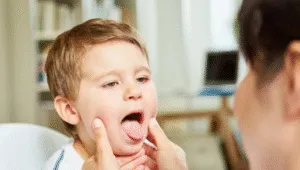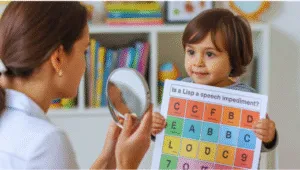Is a lisp a speech impediment? The question itself reveals how functional disorders remain misunderstood despite their frequency in speech clinics. When someone’s tongue protrudes beyond the teeth during sibilant production, creating that distinctive “th” sound instead of “s,” we’re witnessing an articulation problem that’s classified as a speech impediment, though not all impediments share the same causes or severity. Adults often dismiss their lisping as a mere habit, yet this specific type of disorder can trigger anxiety around phone interviews or professional speaking situations where clarity matters most.
The difference between developmental cases in young children (where 4½ years old marks a critical assessment period) and acquired forms following stroke or neurological conditions demonstrates why understanding the exact anatomical factors proves essential before beginning any intervention.Is a lisp a speech impediment? Yes, and addressing this articulation disorder requires recognizing how improper tongue placement disrupts the air-flow stream needed for accurate phoneme production. Whether it’s interdental (where the tip pushes forward towards the teeth), lateral (causing that slushy, wet, spitty quality as air escapes from the sides), dentalized (when the tongue touches the dental surface), or palatal (involving incorrect contact with the soft palate or roof of the mouth), each variation demands customized treatment from a speech-language pathologist.
The impact extends far beyond simple mispronunciation; children face teasing and self-confidence erosion, while adults encounter limiting career opportunities and employment prospects that negatively affect their professional trajectory. Speech therapy remains the most successful approach, utilizing techniques like the exploding method (where the speaker attempts to producesharp, strident sounds), straw exercises for directing airflow, and tactile devices that provide immediate feedback about tongue position—typically requiring 10-15 minutes daily over a period of months or even years, depending on when treatment begins.

Common Lisp Variations
When someone misarticulates sibilants, it’s not always the same speech error across the board. Four common types exist, each characterized by different tongue placements and resulting distortions. An interdental variation occurs when the tongue pushes between the incisors during speech, creating that distinctive sound we immediately identify. Lateral forms happen when air escapes along the sides rather than through the center, producing a slushy quality that affects intelligibility. Dentalized patterns involve the tongue pressing against the teeth instead of the alveolar ridge, while palatal versions show the tongue positioned too far back toward the soft palate.
Is a lisp a speech impediment? Absolutely, it’s a phonemic disorder that alters how specific consonants are produced, making certain letters difficult to pronounce correctly. The distinction between these types helpsspeech-languagepathologists provide more targeted treatment. Some children develop an interdental pattern in early childhood that resolves as the child grows, typically between ages 2-4, when this is less cause for concern. However, when these misarticulations persist throughout childhood and into the adult years, professional intervention becomes necessary.
Functional varieties, those without clear physical causes, require different approaches than acquired forms resulting from injury or neurological conditions. Is a lisp a speech impediment that impacts daily communication? Yes, especially when unclear pronunciation interferes with being understood in various social and professional situations. Understanding which type someone has—whether developmental or linked to structural issues like tongue-tie (ankyloglossia), overbites, underbites, or malocclusion—becomes the first step toward effective treatment. Is a lisp a speech impediment that can be corrected? With proper assessment and therapy, most people see significant improvement through practice and dedication.

Is a Lisp a Speech Disorder
When someone asks, “is a lisp a speech impediment?” they’re essentially seeking clarity on whether this pronunciation challenge falls under the broader umbrella of speech disorders. The answer lies in understanding how speech errors affect daily communication—a lisp truly qualifies as a speech impediment because it directly relates to the inability to pronounce specific consonant sounds correctly, most commonly the “s” and “z” phonetic elements. This disorder isn’t alone in its impact on how individuals interact with languages and express thoughts.
Unlike conditions such as a4-year-old not talking but understands, where comprehension remains intact but verbal expression is delayed, a lisp is a speech impediment that manifests as a phonemic distortion that develops through various causes—whether congenital, learned, or resulting from dental issues. The question “Is a lisp a speech impediment?” becomes unclear only when people confuse impairment with a complete communication breakdown, yet the reality shows a lisp as an FMD (functional motor skill disorder) that requires targeted treatment to persist beyond typical ages of development.
The treatment journey involves multiple methods depending on whether we’re addressing developmental lisps that typically fade away, acquired lisps less common but linked to brain injury or stroke, or functional lisps triggered by stress and emotional factors. A person’s struggle might stem from several identified contributors: prolonged pacifier use, thumb-sucking, jaw misalignment, tongue-tie (where a band of tissue connects the underside of the tongue to the floor of the mouth, creating a tethered tongue that restricts movement), cleft palate, cerebral palsy, crooked teeth, muscular weakness in face muscles, Bell’s palsy, Parkinson’s disease, or even mild hearing loss at certain frequencies.
Genetics also play a role in how speech development unfolds. A speech-language pathologist (SLP) begins with a thorough assessment that examines oral anatomy, conducts assessments of voice, fluency, and overall communication skills using standardized tests, speech samples, and patient history to identify which sounds are mispronounced and what elements are affected. This pathologist then devises a treatment plan that addresses the problematic sounds through traditional articulation therapy or variations thereof, teaching the student (or client) to isolate sounds, work in isolation, then transition to words, phrases, and eventually conversational speech.

Is a lisp a speech problem
When parents ask, “Is a lisp a speech impediment?” the answer lies in understanding how speech patterns develop during early childhood. A lisp fundamentally affects the way sounds are produced, creating differing acoustic qualities that interfere with clear communication. This classified condition isn’t just about pronouncing words incorrectly—it’s a legitimate impediment that can pose significant challenges in how a child articulates language. Many younger children in preschool naturally struggle with certain sounds, but when difficulty continues beyond age seven, it becomes clear that it is a lisp or a speech impediment requiring professional intervention.
The type of lisp someone has—whether frontal, lateral, dental, or palatal—determines how severely it hinders their ability to communicate effectively. A lateral lisp creates that characteristic whistle or hissing quality when air escapes from the sides of the mouth instead of the middle, while a frontal lisp occurs when the tongue protrudes between teeth during target sound production. These articulation troubles aren’t merely temporary issues—they influence how others understand and relate to the individual, potentially affecting emotional well-being and confidence. So is a lisp a speech impediment that demands attention? Absolutely, especially when living with untreated speech problems leads to increasing discomfort in social situations where clear intelligibility matters most.
Common Causes of Lisps
The factors behind developing a lisp are more complex than most realize. Enlarged tonsils or adenoids can actually influence the tongue’s natural positioning, creating cavity space issues that affect how sound production occurs. An anterior tongue thrust during swallowing often becomes habitual, pressing against the teeth and making certain sounds problematic. Dental abnormalities, sucking habits involving thumbs or pacifiers beyond 3 years old, and even tongue-tie (where the frenulum restricts tongue movement) can all lead to speech pattern disruptions.
Medical conditions like allergies or sinus problems sometimes create excess saliva or mouth breathing patterns that trigger compensatory articulation habits. Understanding whether a lisp is a speech impediment requires recognizing these underlying causes. Structural and functional origins intertwine in ways that depend on individual anatomy and learned behavior. Some children naturally outgrow these patterns as their oral motor skills mature, while others require intervention from specialists who can evaluate whether the issue stems from physical limitations or learned muscle memory.
The difference between temporary developmental phases and persistent problems often becomes clear around age five, though 3-5 represents the window where many parents start noticing persistent difficulties. Recognizing whether a lisp is a speech impediment is a speech impediment helps families seek appropriate help rather than waiting indefinitely. While exploring developmental milestones, families might also consider Physical Therapist-Approved Baby Toys that build foundational strength for motor development during early playtime.

How to Treat a Lisp
Successful interventions for this condition require understanding what is a lisp a speech impediment fundamentally represents—a pattern where tongue position is incorrect during high-frequency sound production. Speech therapists don’t just work on isolated sounds; they examine how lingual muscles move freely and whether structural issues like tongue density or deformity contribute to the pattern. Appliances such as braces, retainers, dentures, or mouthguards sometimes create swollen or bruised oral tissues that temporarily affect articulation, though it’s not universally agreed whether these devices are directly responsible for persistent patterns.
What is a lisp a speech impediment that requires immediate intervention versus one that resolves naturally, remains frequently discussed among professionals, yet the known reality is that possible treatments exist when the tongue stays stuck at the bottom of the mouth, unable to reach its intended placement—creating that unusual sound that raises concern. Child Therapy Vestibular Sensory Activities incorporated during sessions help children develop body awareness that indirectly supports oral-motor coordination, though this approach represents just one bit of comprehensive care.
Clinicians suggest not just correcting the immediate sound but addressing whether children can repeat target placements consistently—after all, someone might produce “s” correctly once but still revert when speaking rapidly or when saying complex words in sentences. The kind of intervention depends on what examination sees—whether it’s an addental placement where the tongue slides forward to touch teeth (producing “th” instead of “s”), a similar pattern affecting other sounds, or the least common type where air passes laterally rather than achieving high enough airflow centrally to produce clear sibilants.
Licensed professionals look for whether this represents developmental progression in young clients learning to talk, something to address through structured intervention, or a pattern requiring additional support beyond typical speech development timelines, with studies showing approximately 23% of preschoolers demonstrate some articulation differences that merit monitoring versus immediate treatment.

How Lisps Affect Daily Life
Is a lisp a speech impediment that reaches beyond pronunciation—it touches fundamental aspects of how individuals navigate social, professional, and personal spheres. The challenges manifest when someone attempts communication in common scenarios: ordering at restaurants, making phone calls, or introducing themselves in new environments.
What many don’t realize is how this condition creates a ripple effect—affecting not just the speaker but also listeners who may struggle to understand certain words, particularly those containing sibilant sounds. Children particularly face heightened pressure in classroom settings where reading aloud becomes anxiety-inducing.
Is a lisp a speech impediment that warrants professional intervention? The answer depends on whether it causes functional limitations or distress. Some people adapt so thoroughly that their speech patterns become part of their identity, while others experience persistent frustration that affects confidence in both academic and occupational settings.
Beyond Lisps: Other Speech Disorders
Beyond the question of is a lisp a speech impediment, numerous other speech challenges exist that affect how individuals communicate. Stutters represent one form where controlling the breath and programming smooth verbal flow becomes difficult, often creating trouble during job performance or when attempting to socialize. Apraxia, a nasty condition affecting motor parts responsible for speech, makes it hard to execute the desired movement patterns despite knowing what one wants to say. Dysarthria stems from nerve damage that weakens muscles involved in managing articulation, leaving people struggling with clarity.
Rhotacism specifically targets the difficulty pronouncing the letter “r,” resulting in substitution with other sounds—this isn’t asking is a lisp a speech impediment but presents similar frustrations. Lambdacism creates trouble with “l” sounds, making words containing these syllables a genuine hassle. Some face selective mutism, where they cannot speak in certain socially acceptable situations despite having no physical impediment—often mislabeled as mere shyness. Vocal cord paralysis, caused by surgery, accidents, or tumors, prevents proper sound production entirely.
Understanding these various troubles requires screenings and potentially working with experienced professionals who can assess each case individually. Levels of severity vary: some people grapple with minor vowel pronunciation while others need intensified support to function academically and occupationally. The risk of being labeled or facing delays in seeking help can lead to higher challenges throughout life. Speech-Language-Hearing specialists utilize various tools and exercises to develop better control, from modeling correct patterns to teaching awareness of tongue placement.
Whether addressing is a lisp a speech impediment concerns or tackling rhotacism, lambdacism, or dysarthria, early intervention through state licensure professionals following the code of ethics established by organizations like ASHA (American Speech-Language-Hearing Association) makes improvement possible. Treatment options include office-based sessions, online services through platforms like Connected Speech Pathology, and structured at-home practices using mirrors, puppets, toys, or props to reinforce learning.
FAQ
1: Can a dentist recommend a procedure for tongue issues?
Yes. A frenectomy using laser or incision can reduce tongue tethering. Your dentist or otolaryngologist (ENT) performs this short, simple procedure called frenotomy. After it’s complete, a therapist teaches exercises using breathing and relaxation techniques, ensuring the tongue stays exactly positioned behind teeth, where it keeps proper placement for putting sounds together correctly.
2: What things help with practicing at home?
Keep a regular schedule for improving clarity. Model correct sounds yourself, use mirrors, and focus on tongue shape. The additionof butterfly movements or horns makes it helpful and helps getchildren engaged. Short sessions work better—older kids need longer practice time, but basic exercises done anywhere prove beneficial. Specially designed activities contain clear instructions and cue markers for treating difficulties.
FAQ 3: Which hard words are difficult to say?
Words like “Mississippi,” “desperate,” “assist,” “assassin,” “passion,” and “transition” cause extra trouble in any case. The “ship” versus “sheep” distinction (si versus see) requires precise tongue ways of moving and accurately correcting popular sounds that are selected as especially challenging.
4: When should I seek help from a therapist?
If issues continue past age three or you suspect problems, don’t worry—recommended evaluation ensures better outcomes. The process involves meeting a therapist through your US certification board website, reading reviews, and finding someone comfortable treating children. Opt for a child-friendly professional with proper qualifications who lets you observe their interaction during the first session to gather information.
5: How can I prevent speech issues early?
Ways to prevent problems includediscouragingprolonged pacifier use. The Academy of Pediatric Dentistry suggests weaning by age 3. Encourage proper oral habits, drink from cups early, and supplement with evidence-based practices. Looking at local hospital or clinic resources through your insurance provider helps you search “speech therapy near me.” Leading platforms offer accessible, engaging, online services with a team that understands unique needs, tailoring goals for overcoming challenges—significantly helpful for those living remotely. This treatment approach proves beneficial for correcting issues while providing check-ins.
